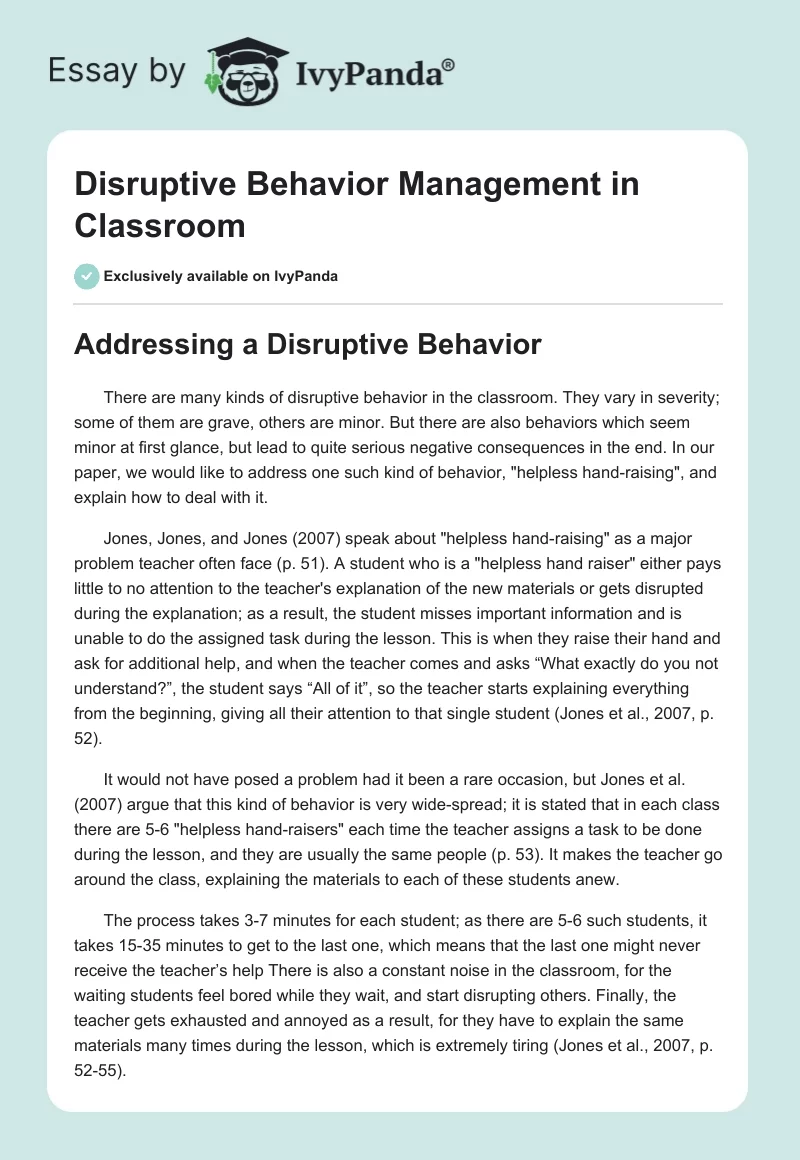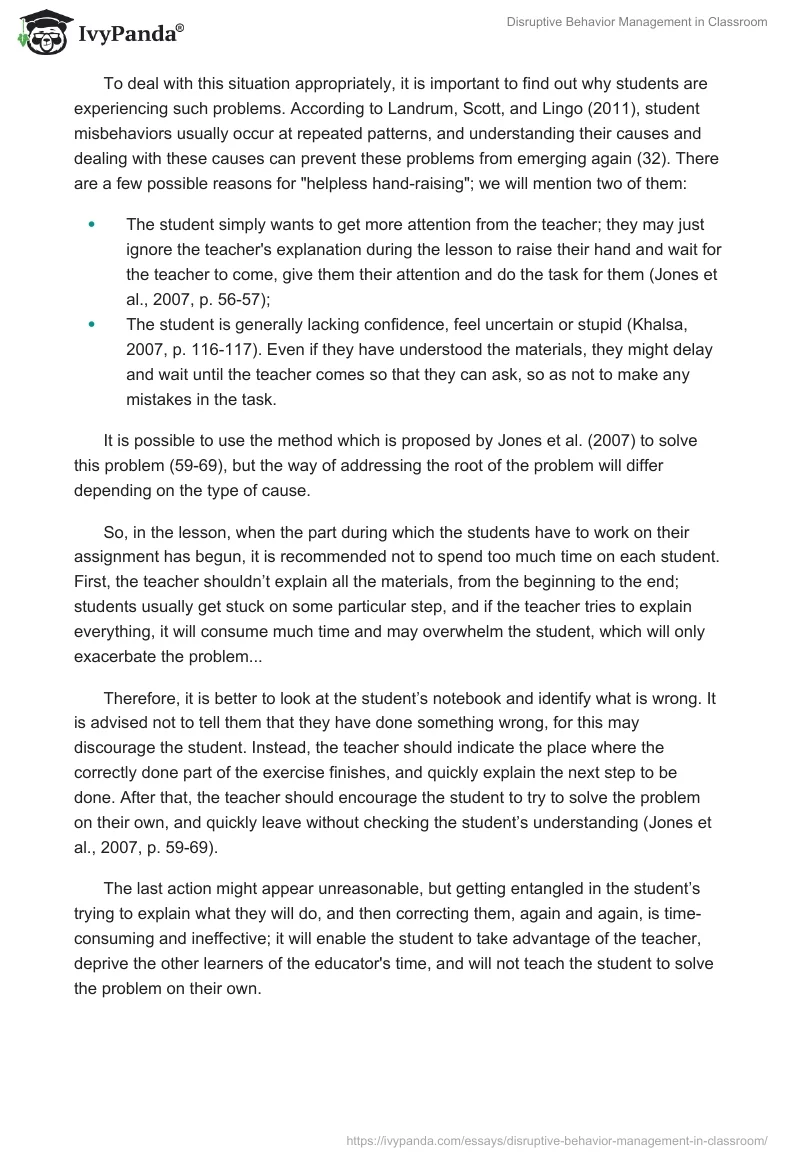Addressing a Disruptive Behavior
There are many kinds of disruptive behavior in the classroom. They vary in severity; some of them are grave, others are minor. But there are also behaviors which seem minor at first glance, but lead to quite serious negative consequences in the end. In our paper, we would like to address one such kind of behavior, “helpless hand-raising”, and explain how to deal with it.
Jones, Jones, and Jones (2007) speak about “helpless hand-raising” as a major problem teacher often face (p. 51). A student who is a “helpless hand raiser” either pays little to no attention to the teacher’s explanation of the new materials or gets disrupted during the explanation; as a result, the student misses important information and is unable to do the assigned task during the lesson. This is when they raise their hand and ask for additional help, and when the teacher comes and asks “What exactly do you not understand?”, the student says “All of it”, so the teacher starts explaining everything from the beginning, giving all their attention to that single student (Jones et al., 2007, p. 52).
It would not have posed a problem had it been a rare occasion, but Jones et al. (2007) argue that this kind of behavior is very wide-spread; it is stated that in each class there are 5-6 “helpless hand-raisers” each time the teacher assigns a task to be done during the lesson, and they are usually the same people (p. 53). It makes the teacher go around the class, explaining the materials to each of these students anew.
The process takes 3-7 minutes for each student; as there are 5-6 such students, it takes 15-35 minutes to get to the last one, which means that the last one might never receive the teacher’s help There is also a constant noise in the classroom, for the waiting students feel bored while they wait, and start disrupting others. Finally, the teacher gets exhausted and annoyed as a result, for they have to explain the same materials many times during the lesson, which is extremely tiring (Jones et al., 2007, p. 52-55).
To deal with this situation appropriately, it is important to find out why students are experiencing such problems. According to Landrum, Scott, and Lingo (2011), student misbehaviors usually occur at repeated patterns, and understanding their causes and dealing with these causes can prevent these problems from emerging again (32). There are a few possible reasons for “helpless hand-raising”; we will mention two of them:
- The student simply wants to get more attention from the teacher; they may just ignore the teacher’s explanation during the lesson to raise their hand and wait for the teacher to come, give them their attention and do the task for them (Jones et al., 2007, p. 56-57);
- The student is generally lacking confidence, feel uncertain or stupid (Khalsa, 2007, p. 116-117). Even if they have understood the materials, they might delay and wait until the teacher comes so that they can ask, so as not to make any mistakes in the task.
It is possible to use the method which is proposed by Jones et al. (2007) to solve this problem (59-69), but the way of addressing the root of the problem will differ depending on the type of cause.
So, in the lesson, when the part during which the students have to work on their assignment has begun, it is recommended not to spend too much time on each student. First, the teacher shouldn’t explain all the materials, from the beginning to the end; students usually get stuck on some particular step, and if the teacher tries to explain everything, it will consume much time and may overwhelm the student, which will only exacerbate the problem…
Therefore, it is better to look at the student’s notebook and identify what is wrong. It is advised not to tell them that they have done something wrong, for this may discourage the student. Instead, the teacher should indicate the place where the correctly done part of the exercise finishes, and quickly explain the next step to be done. After that, the teacher should encourage the student to try to solve the problem on their own, and quickly leave without checking the student’s understanding (Jones et al., 2007, p. 59-69).
The last action might appear unreasonable, but getting entangled in the student’s trying to explain what they will do, and then correcting them, again and again, is time-consuming and ineffective; it will enable the student to take advantage of the teacher, deprive the other learners of the educator’s time, and will not teach the student to solve the problem on their own.
Let us consider an example of a situation. The class is practicing problems with fractions and common denominators. The teacher gives the class a problem: 2/5 + 4/7, and six students raise their hands. The teacher comes up to Johnny first and sees:
- 2/5 + 4/a = /
Johnny says: “I understand nothing”.
The teacher says: “So, it’s good, you actually do understand that you need to change something at this step, do something with these numbers because you haven’t written anything further”. (It encourages Johnny a little.) “Now tell me, do you remember that we can multiply both the numerator and the denominator of a fraction by the same number, and the value of the fraction will not change?”
“Well, maybe…”
“So, you have heard about it, yeah? Try to get the common denominator using this trick, and I’ll check on you later,” the teacher says and goes to the next student.
As we see, this conversation should not take more than one minute (probably less), and there is a good chance that Johnny will be able to solve the problem. The teacher will check on him later and will help him if there are complications. Had the teacher asked what the problem was, Johnny would have taken a lot of time trying to put together the explanation of what he didn’t understand.
It also should be mentioned that the reasons for such behavior of the student should be addressed separately. For instance, if the problem is that the student wants more attention, it is better to provide them with that attention whenever an opportunity comes; for instance, if the teacher has occasionally noticed that the student has done something well, they should always praise the student for doing that (e.g. “Thank you for wiping the board, I didn’t have much time to do that”). It will also encourage the student to do good things.
If the student feels stupid and is afraid of failure, the teacher should talk to them after the class to e.g. find out what they can do well (for instance, play the piano), why they can do that well (because they have practiced enough), and encourage them by saying that they can do as well in the subject if they practice enough, too (Marzano, Marzano, & Pickering, 2003, p. 57).
As we have seen, “helpless hand-raising” is a type of disruptive behavior that might seem minor at the first glance, but can lead to teacher’s exhaustion, bad discipline in the classroom, and “hand-raisers” learning nothing on their own. This issue can be dealt with easily, though, by praising the student, giving them a quick explanation of the next step, and moving to the next learner.
References
Jones, F. H., Jones, P., & Jones, J. L. (2007). Tools for teaching: Discipline, instruction, motivation (2nd ed.). Santa Cruz, CA: Fredric H. Jones & Associates. Web.
Khalsa, S. K. (2007). Teaching discipline & self-respect: Effective strategies, anecdotes, and lesson for successful classroom management. Thousand Oaks, CA: Corwin Press, Sage Publications. Web.
Landrum, T. J., Scott, T. M., & Lingo, A. S. (2011). Classroom misbehavior is predictable and preventable. Addressing challenging behavior in the classroom: Prediction, prevention, and instruction. Phi Delta Kappan, 93(2), 30-34. Web.
Marzano, R. J., Marzano, J. S., & Pickering, D. (2003). Classroom management that works: Research-based strategies for every teacher. Alexandria, VA: ASCD.


